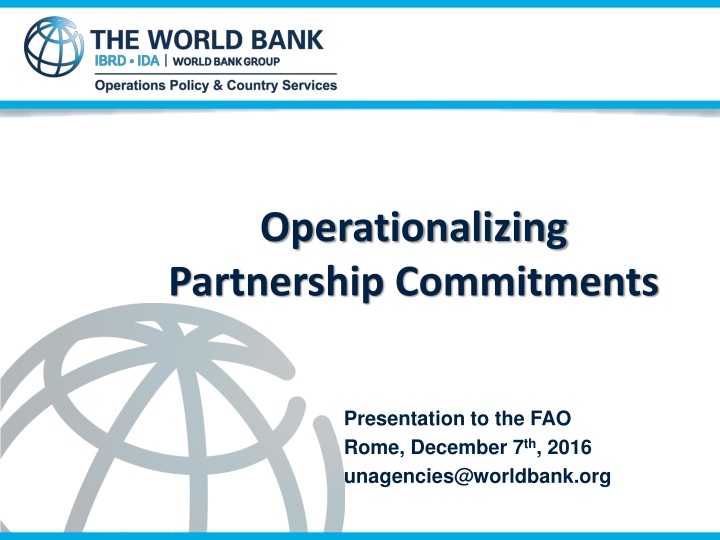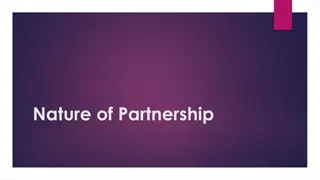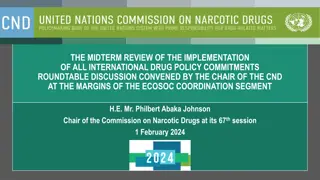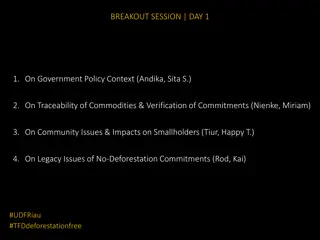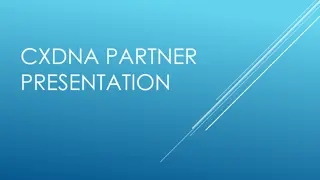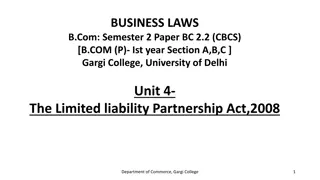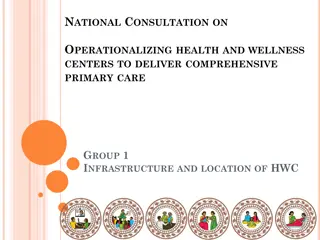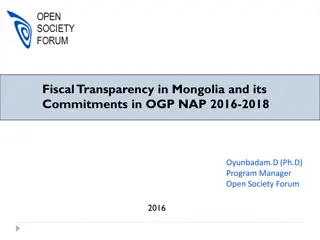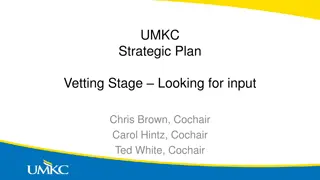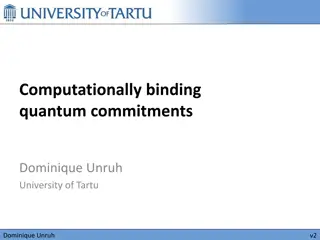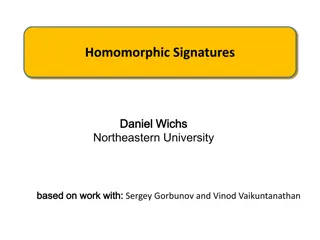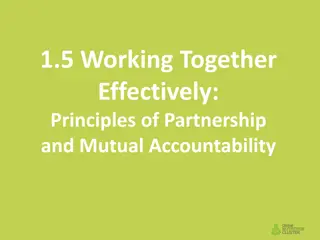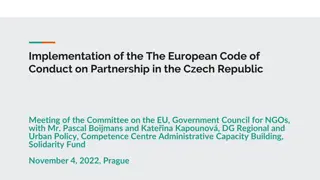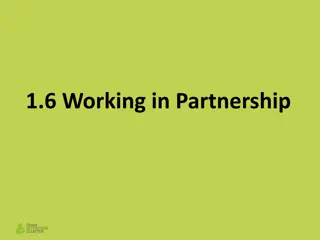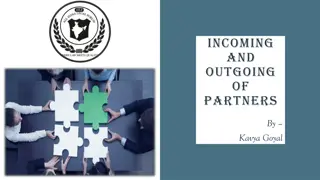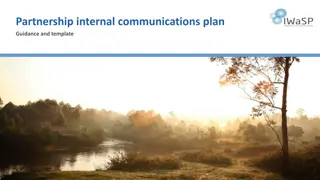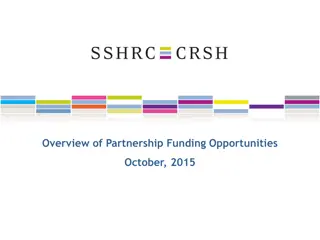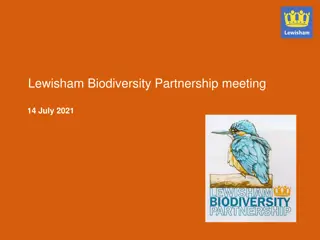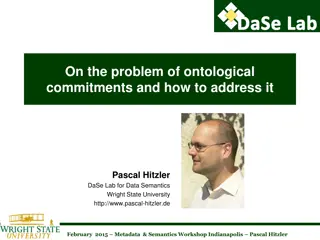Operationalizing Partnership Commitments
Raise awareness about engaging UN organizations under Bank-financed operations. Overview of engagement options, financing modalities, and future strategy focusing on IBRD and IDA member organizations. Learn about the World Bank Group basics, important partnerships, and the 2014 WBG reorganization aiming for effectiveness and strategic focus. Discover the ongoing reforms at the World Bank Group to strengthen its support for poverty reduction and client service.
Download Presentation

Please find below an Image/Link to download the presentation.
The content on the website is provided AS IS for your information and personal use only. It may not be sold, licensed, or shared on other websites without obtaining consent from the author.If you encounter any issues during the download, it is possible that the publisher has removed the file from their server.
You are allowed to download the files provided on this website for personal or commercial use, subject to the condition that they are used lawfully. All files are the property of their respective owners.
The content on the website is provided AS IS for your information and personal use only. It may not be sold, licensed, or shared on other websites without obtaining consent from the author.
E N D
Presentation Transcript
Operationalizing Partnership Commitments Presentation to the FAO Rome, December 7th, 2016 unagencies@worldbank.org
Objective Raise awareness about options of engaging UN organizations under Bank- financed operations unagencies@worldbank.org
AGENDA Overview Engagement Options and Financing Modalities Standard Agreements Future Strategy
Focus today on IBRD and IDA Member Organizations International Bank for Reconstruction and Development (IBRD) International Finance Corporation (IFC) International Development Association (IDA) International Centre for the Settlement of Investment Disputes (ICSID) Multilateral Investment Guarantee Agency (MIGA) 5
World Bank Group Basics Products and Services 6
IMPORTANT PARTNER Long history or partnership (1947 UN- IBRD Agreement) Same family (WB a specialized UN agency) Overlapping agendas (global issues, MDGs/SDGs/ 2030 agenda, humanitarian development and crises response) 7
2014 Reorganization In 2014 the WBG launched a comprehensive reform process to become more effective, and more strategically focused. Through the reform the WBG aimed to: Focus on results, science of delivery, transformational engagements, and taking informed risks Improve information-sharing and learning by reorganizing into 14 global practices with 5 cross-cutting solutions Overhaul WBG procurement policies to encourage high-value high-risk projects, innovation, and the use of client procurement systems Reduce overall budget by USD 400 million over the period 2014-2017. 8
! WORLD BANK REFORM The World Bank Group is currently undergoing a series of reforms to make it a stronger and more strategically aligned entity. In doing so, the Bank is (a) modernizing its lending and knowledge products and services to better serve its clients and support their efforts to reduce poverty; (b) improving the way the institution shares and accesses knowledge and expertise from inside and outside the institution; and (c) modernizing the processes and systems underpinning the Bank s work. The World Bank aims to sharpen its focus on results, science of delivery, transformational engagements, and taking informed risks. To foster this culture, the Bank is going through a consolidation and reorganization process, aiming to share knowledge and expertise more effectively. New Global Practices and Cross-Cutting Solution Areas have been established to reflect this effort. Previously most of the work was conducted by the Bank s six regional Vice Presidency Units (VPUs). This set up has been reorganized into 14 Global Practices and 5 Cross-Cutting Solution Areas as of July 1, 2014: Global Practices 1. Agriculture 2. Education 3. Energy and Extractives 4. Environment and Natural Resources 5. Finances and Markets 6. Governance 7. Health, Nutrition and Population 8. Macroeconomics and Fiscal Management 9. Poverty 10. Social Protection and Labor 11. Trade and Competitiveness 12. Transport and ICT 13. Urban and Social Development 14. Water New Structure - Sectors Cross-Cutting Solutions 1. Climate Change 2. Fragility, Conflict and Violence 3. Gender 4. Jobs 5. Public Private Partnerships Alongside the new emphasis on a science of delivery, is the ongoing overhaul of WB procurement policies and procedures. The most significant shift appears to be the move to a risk-based approach to ensure focus and priority on higher value and higher risk projects, rather than on transactions. The WB also intends to promote a fit-for-purpose approach, that allows for innovation, and state-of-the-art technologies & best practices. There is also a move towards making progressive use of client procurement arrangements, as it may be appropriate in investment operations, which will go hand-in-hand with support for client capacity building with an emphasis on lower income countries. Finally the WB will also support borrowers better execute and manage contracts through assessments of institutional capacity. Finally, the Bank has set out to achieve an overall budget reduction of $400 million over the next three years. While the focus so far has been on administrative reforms, and economies of scale, the reform will inevitably see a reduction of operational personnel, possibly weakening the Bank s supervision and operation management capacity. The drive towards an increase in effectiveness of delivery in WB operations in FCSs, coupled with a need for increased capacity development and support to national governments is very much in line with UNOPS mandate. PROGRAMMING AND PROJECT CYCLE The World Bank and its borrowers have different roles and responsibilities in both the decision making process for projects to be implemented and in procurement. In the project life cycle, the Bank generally has the following roles: (i) identify project/program; (ii) appraise project/program and assess risk; (iii) share knowledge and information; (iv) supervise project/program; and (v) monitor compliance with agreements. Meanwhile, the borrower has the following roles: (i) identify project/program; (ii) design, prepare, and plan 9 DRAFT& FOR& INTERNAL& USE& ONLY.&
WB Key Units for UN Partnership Commitments/Global Priorities President Lead SDGs Agenda Engagement Modalities OPCS SVPMM Global Practices / Cross-Cutting Solution Areas Technical and Sector Lead Regions Operationalized Engagements Task Teams
Global Support Team (GST) Sr. Vice President for the SDGs, UN Relations and Partnerships Coordination on UN Agencies GST New York Geneva UN Agencies Secretariat in OPCS Fragility, Conflict and Violence- CCSA World Bank Task Teams Information sharing Coordination 20 Reporting
Engagement Modalities Programming Cycle Country Assistance Strategy The WB and borrowing government jointly identify priority sectors and specific projects Project Identification Evaluation Upstream engagement The borrowing government is responsible for the project preparation (WB shadows) Project Supervision Project Preparation The borrowing government implements Downstream engagement Project Appraisal Implementation The WB appraises and approves. Loan Approval and Signing Loan Negotiations 10 Joint Activity World Bank Activity Borrower Activity
Engagement Modalities Country Partnership Framework/ Systematic Country Diagnostic The following framework has been developed to enhance the Bank s efforts to reduce extreme poverty and boost shared prosperity in developing countries. Previously known as Country Assistance Strategy (CAS), World Bank has launched a new programming framework as of 2014 known as Country Partnership Framework (CPF), which generally covers a 4-6 year programming cycle The CPF is preceded by the Systematic Country Diagnostic (SCD), which informs the strategy and identifies the most important challenges and opportunities In most fragile states cases CPF is usually replaced by an Interim Strategy Note (ISN) 11
FINANCING OF THE UN FY06-FY16 UN Agency Total Financing In FCV UNICEF $1.5 billion $180 million UNOPS $500 million $250 million UNFPA $400 million $65 million WHO $300 million $50 million WFP, FAO $200 million $100/125 million UNDP $200 million $90 million ILO $60 million $30 million 16
DIRECT FINANCING $ legal agreement 18
Engagement of UN Agencies Under WB Financing Grants: WB UN implements all or part of an activity funded by WB FMFA Requirements Any operation Single country or regional project UN Agency is FMFA signatory FMFA Grant UN s FM procedures apply WB Procurement policy apply UN Agency implements operation for Gov t Terms RETF (R = UN) FPA Requirements Emergency operation MDTF set up for this operation All donors agreed to FPA application UN Agency is FPA signatory FPA Grant s Terms UN Agency implements operation for Gov t UN s FM & Procurement procedures apply WB as Trustee Without Fiduciary Oversight of IE FIF Grants Terms Transfer $ Transfer $ Donors UN Agency (IE) Donor-agreed procedures apply Governing Body Terms Grants $ (RETF) WB (IE) UN Agency (IE) See RETF Terms Reporting on Use of Funds BB/BETF (B=WB) UN Agency carries out activity for WB (e.g. Haiti, study on damage assessment) WB Corporate Procurement contracts UN Agency Terms Vendor Contract UN s FM and Procurement procedures apply within contract WB Legal (LEGIA) coordinates Ancillary Agreement Terms UN Agency organized events (conferences, workshops) UN own procedures/policies Glossary WB Administered Budget Bank Executed Trust Fund Civil Works Financial Intermediary Fund Financial Management Framework Agreement BB BETF CW FIF FMFA Fiduciary Principles Accord Implementing Entity Multi-Donor Trust Fund Procurement Agent Reimbursable Advisory Services FPA IE MDTF PA RAS Recipient Executed Trust Funds Supply Agreement Technical Assistance RETF SA TA Issued by: Unagencies@worldbank.org v5. October 2016
FMFA and FPA Institutional level agreements Designed for grants only, but Agreed fm, procurement, fraud and corruption provisions are used in other tools UN Agencies New working Arrangements 20
INDIRECT FINANCING UN Agency Borrower Bank Financing Agreement $ Agreement 21
Indirect Engagements via Bank Borrowers Due to limited availability of Bank grants, this indirect method of engagement is likely to continue as the major source of Bank funding for UN Agencies (the UN Agencies cannot themselves borrow and repay IBRD loans or IDA credits). 22
Engagement of UN Agencies Under WB Financing Lending: WB Government UN RETF/IDA/IBRD credit/grant/loan (R Standard Template for UN Agency (SA/TA/Output) Terms UN s FM & Procurement procedures apply within contract 2. 1. Legal Agreemen t WB Gov t Contract OR Standard Template (PA/IE/CW) Terms 2. UN s FM procedures apply WB Procurement procedures apply Contract = Gov t) OR 3. Vendor Contract UN Agency Implements on Behalf of Gov t Terms UN s FM & Procurement procedures apply within contract 1. Legal Agreemen t WB Gov t 2. Emergency Request to Contract UN Directly Non-Lending: Gov t WB UN RAS Single TA 1. RAS $ Stream WB RAS Team 2. Subcontracting UN Gov t Agency 3. TA OR 1. RAS $ RAS Combined TA WB RAS Team Gov t 3. TA 2. MOU 3. TA UN Glossary WB Administered Budget Bank Executed Trust Fund Civil Works Financial Intermediary Fund Financial Management Framework Agreement BB BETF CW FIF FMFA Fiduciary Principles Accord Implementing Entity Multi-Donor Trust Fund Procurement Agent Reimbursable Advisory Services FPA IE MDTF PA RAS Recipient Executed Trust Funds Supply Agreement Technical Assistance RETF SA TA Issued by: Unagencies@worldbank.org v5. October 2016
How to find Projects Country Intelligence Current status $ to Borrower Description All programming documents are published in the WB projects website as part of the WB transparency policy The information includes for both ongoing projects and projects in the pipeline. Further information can be found via World Bank s Project Website which can further filtered active, closed, pipeline projects 13
Project Information Project Document, Financing Agreement: Identify project components and specific entry points Procurement plan: Identify specific activities foreseen where UN Agency can provide support Implementation status reports: Identify project implementation issues (risk, delivery, etc.) 14
STANDARD AGREEMENTS Used by Borrowers under indirect financing option Main engagement option (90% overall financing to UN) Mix: contractual relationship and recognition of partnership UN Agencies New working Arrangements 27
TWO TYPES FOR FAO 1. Technical Assistance 2. Output-based 28
STRUCTURE Same structure across templates: Form of Agreement General Conditions Annexes General Conditions are broadly harmonized across UN agencies Framework type
OUTPUT AGREEMENT I. Agreement (Gov <-> UN) Outputs Inputs Activities Deliverables II. Project (Gov <-> WB) Project Outcomes
IMPORTANT FEATURES OUTPUTS Focus on deliverables Payments and Reporting are linked to deliverables No limits on any type of inputs Own rules/procedures Infrastructure Aspects Covered under agreement
Future Strategy Current strategy is to develop standard templates for top 10 UN agencies, while continuing to use FPA/FMFA grants where appropriate. Longer term strategy may envisage developing a new institutional-level fiduciary agreement with the UN to apply to any both direct and indirect financing options Objective is to: further simplify engagement modalities provide enhanced fiduciary assurance over all of the funds spent through UN Agencies UN Agencies New working Arrangements 32
GLOBAL SUPPORT TEAM for UN Agencies Engagement under WB- financed Operations (unagencies@worldbank.org)
